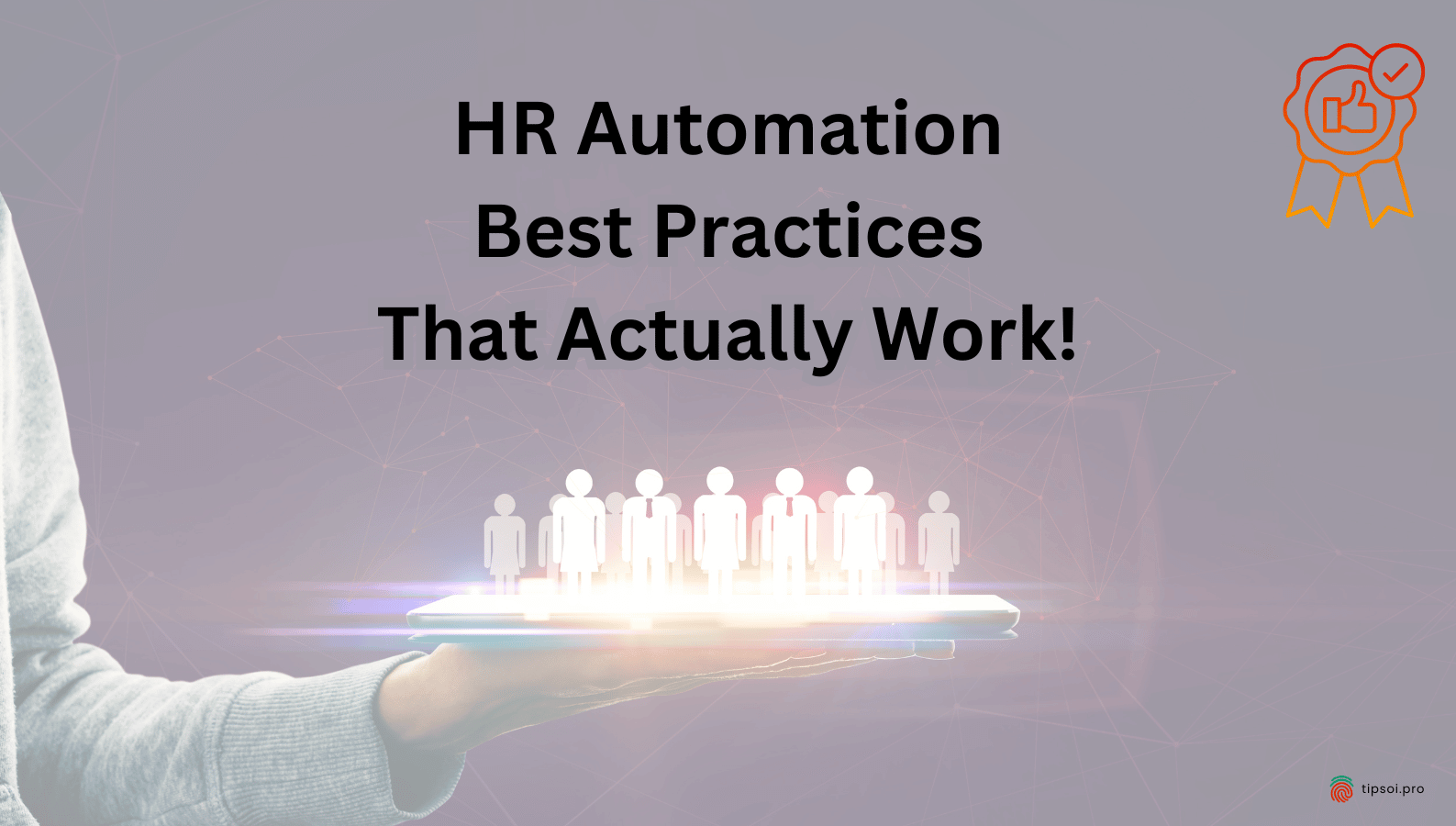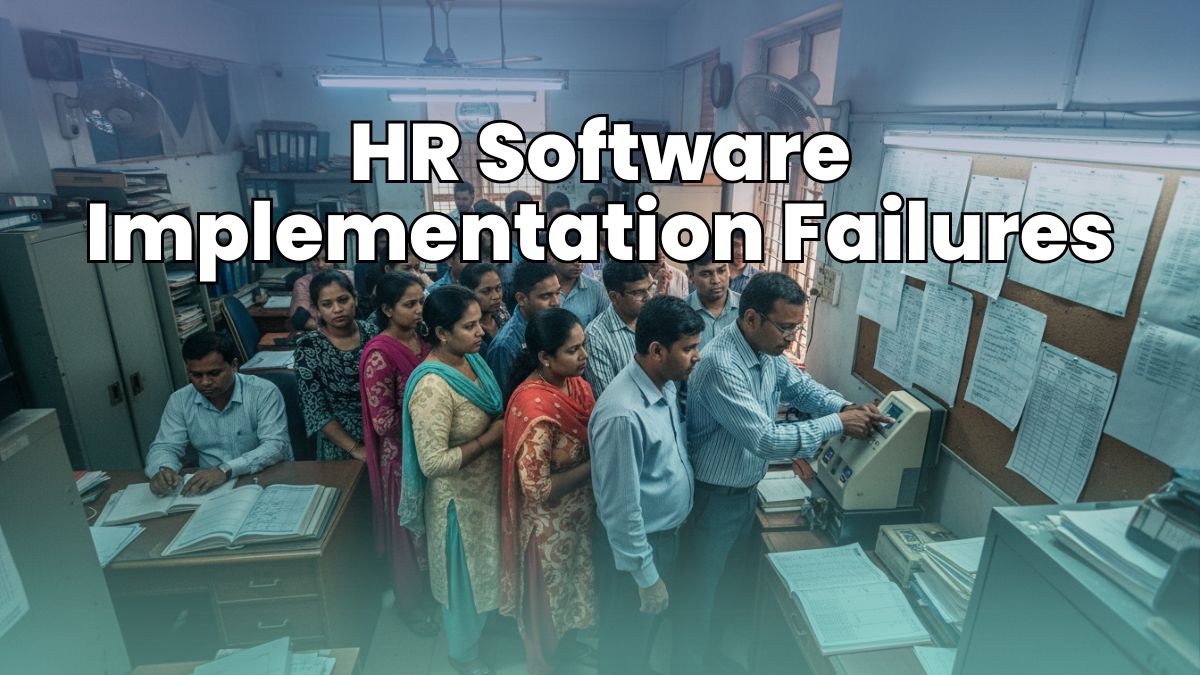HR Automation Best Practices extend beyond implementation. Continuous monitoring and evaluation are crucial to ensure the system’s effectiveness and make data-driven adjustments as needed. But first, what is HR automation? HR automation refers to leveraging technology to streamline repetitive HR tasks such as payroll, recruitment, and performance management, enabling HR teams to focus on strategic initiatives.
Additionally, understanding HR automation meaning is vital to set the right expectations. HR automation encompasses tools and solutions designed to automate tasks like HR policy management automation, payroll processing, and employee onboarding. These tools not only save time but also reduce errors and improve overall efficiency.
Before embarking on this journey, it’s essential to evaluate is HR ready for automation. Assessing your organization’s readiness by analyzing existing workflows, employee adaptability, and IT infrastructure ensures a smoother transition. Setting clear HR automation objectives, such as improving efficiency, reducing administrative burdens, or enhancing employee experience, will guide you in implementing a successful system.
As we move into 2025, staying informed about emerging HR automation trends is crucial for maintaining a competitive edge. Some key trends include AI-driven analytics that enhance decision-making, hyper-personalized recruiting processes to attract top talent, and advanced cloud-based platforms designed for remote workforce management. Additionally, sustainability-focused HR tech solutions are gaining traction as companies prioritize eco-friendly practices
Staying informed about HR automation trends, such as AI-powered analytics or advanced cloud-based systems, can also help you remain competitive in a rapidly evolving landscape. Furthermore, exploring examples of HR automation projects can provide valuable insights into how companies have successfully implemented these systems. For instance, advanced payroll systems represent a key area where advanced payroll automation for workforce has streamlined operations significantly.
We get it – HR can feel like an endless treadmill of paperwork, data entry, and compliance headaches. However, with careful planning and execution, HR automation can transform these challenges into opportunities for growth and efficiency.
1. Start with a Clear Plan
It’s like setting sail without a map if you jump into technology without a plan. You need a clear plan that lists your tools, your goals, and when they need to be done. Figure out which HR tasks can be automated most effectively.
Scalability and customization are critical factors when implementing HR automation. As your business grows, your HR systems should be able to handle increased workloads without compromising efficiency. Additionally, customizable solutions allow you to tailor workflows, reports, and integrations according to your organization’s unique requirements. What is it? Is it hiring, paying, or managing performance? Set objectives based on what your company needs.
For example, Unilever, a global company that makes consumer items, started a full HR change journey in 2017. They began with a clear goal: to make the HR department more flexible and data-driven so that it could support their big growth plans. This was done in stages over several years, with automated tasks like hiring, training, and managing employee success. They said that by 2020, administrative chores would take half as much time, giving HR workers more time to work on strategic projects and staff growth. One of the fundamental HR Automation Best Practices is to begin with a well-defined plan, outlining your goals, timelines, and key performance indicators (KPIs).
Tip: Make a road map. Divide the process of automating into steps that you can handle. This will help you see how far you’ve come and stay on track.
Time is Money: Save Both with HR Automation
2. Choose the Right Tools
Not every automatic tool is the same. It’s important to pick software that works well with the systems you already have and meets your wants. Before making a choice, do a lot of study, read reviews, and ask for demos. When choosing the right tools for HR automation, consider platforms that align with your organization’s needs. For example, BambooHR is perfect for small to medium-sized businesses looking for self-service options and performance tracking. HiBob caters to global teams with payroll integration and employee engagement tools, while Zoho People provides end-to-end solutions like time tracking and compliance management.
Advanced payroll automation is transforming workforce management by integrating time tracking systems, tax compliance tools, and benefits administration into one streamlined solution. These systems reduce errors, save time during payroll processing cycles, and improve employee satisfaction by ensuring timely payments.
When Netflix chose to update its HR tools in 2012, it didn’t just follow the first automation trend it saw. They carefully looked at a lot of different providers, making sure that the new system would work well with their old IT system and be able to grow with the business, which has grown from about 25 million users in 2008 to over 230 million today. This strategic method worked: within two years of putting it into place, Netflix said that HR productivity had gone up by 50%. (Source). Selecting the appropriate tools is a cornerstone of HR Automation Best Practices. Remember, not all solutions are created equal; prioritize compatibility, scalability, and security features.
Tip: Talk to your IT staff and include them in the process of choosing. They can tell you a lot about how well a system works with other systems and how safe it is.
3. Employee Training
It can be hard to teach old dogs new tricks when you introduce new technology. Employees may not want to change or feel overwhelmed by it. To help them change easily, they need to be properly trained.
For example, Adobe Systems knew how important thorough training was when they switched to a new cloud-based HR system Workday in 2017. They held in-depth training classes, made detailed user guides, and set up a help team to deal with any issues employees had. Because of this, 89% of workers said they felt comfortable using the new system within the first month, which kept things running smoothly and reduced the number of problems. Comprehensive employee training is a vital component of HR Automation Best Practices. Empower your workforce to embrace the new technology with confidence through hands-on sessions, clear user guides, and readily available support.
Tip: Give hands-on training and make guides that are easy for people to follow. Always be there for your workers and urge them to ask questions. You might want to make tech-savvy team members the ones to go to for help with problems.
10 Benefits of HR Automation: With Real-Life Examples
4. Data Security
Taking care of private employee data is like watching over a prize box. Data leaks are more likely to happen when things are automated, so security must be a top concern.
Do you remember the 2017 Equifax hack? They lost the personal information of more than 143 million people, which cost them billions of dollars in lawsuits and did a lot of damage to their image.
To ensure robust data security in 2025, follow these best practices:
- Use advanced encryption methods to protect sensitive information during storage and transmission.
- Implement multi-factor authentication (MFA) for all users accessing HR systems.
- Conduct regular audits to identify vulnerabilities in your system.
By prioritizing security measures, you can safeguard employee data while leveraging the benefits of automation.
Tip: Use strong security methods like encryption and two-factor login to keep your information safe. Update your program often and check for security holes. Teaching your staff about how to keep info safe is important. Pick robotic tools that have strong security features.
5. Integration
Think about trying to put puzzle pieces from different sets together. It can be hard to combine new automatic tools with systems that are already in place. It’s very important that info can easily move between systems.
For example, when Johnson & Johnson started their HR change project in 2018, it was a big job to connect their new cloud-based HR software to their old systems. They put a lot of time and effort into working closely with their IT team to make sure that data flow would not be interrupted. By putting integration first from the start, they were able to cut HR costs by 30% and get a lot more employees to use self-service within the first year.
Tip: Work closely with your IT team to find problems that might come up with integration. Before putting the tools to full use, test them in a controlled setting. Use APIs to make it easier for systems to talk to each other and get rid of data silos.
Building a Data-Driven HR Department with Automation: Quick Tips for Modern Managers
6. Monitor and Evaluate
Things can’t be left alone once technology is set up. You need to keep an eye on things and evaluate them often to make sure they are going well and that your goals are being met.
Take the company Google. They didn’t just set up their People Analytics department and forget about it when they did it in 2007. They keep an eye on important measures all the time, like success data, employee involvement, and retention rates. By looking at these findings, they’ve changed their HR policies and programs based on data, which has reportedly led to a significant rise in employee happiness over the years.
Companies like Unilever and Adobe Systems have demonstrated how strategic HR automation can transform workforce management. For instance, Unilever implemented an AI-driven recruitment system that reduced hiring time significantly by automating candidate screening and engagement. This allowed their HR teams to focus on more strategic tasks, such as talent development and employee engagement. Similarly, Adobe Systems utilized automation to streamline performance reviews, ensuring timely feedback and improving employee satisfaction. These examples highlight how automation, when implemented thoughtfully, can drive efficiency and foster a better employee experience.
Beyond these examples, HR automation has proven its value across various industries. For instance, in healthcare, automating credential verification reduces onboarding time from weeks to days. In financial services, compliance processes are streamlined through automation, ensuring adherence to strict regulatory standards. Retail businesses benefit from automated scheduling tools that optimize workforce efficiency during peak seasons.
HR Automation Best Practices extend beyond implementation. Continuous monitoring and evaluation are crucial to ensure the system’s effectiveness and make data-driven adjustments as needed.
Tip: Setting up KPIs is a good way to see how well your automation efforts are going. Do reviews on a regular basis and ask people for feedback. Prepare to make changes based on facts about performance and feedback from users.
7. Maintain the Human Touch
Automation can do jobs that need to be done over and over, but HR is really about people. It’s important to keep things personal when you talk to your workers.
This balance is shown very well by Southwest Airlines. They put their “people-first” mindset first, even though they do a lot of HR technology. They keep lines of communication open, support comments from employees, and make sure that managers have regular one-on-one meetings with their team members. Because of this focus on people, the company has a reputation for being one of the best places to work and consistently high employee participation numbers.
Tip: Automate administrative tasks, but keep people involved in tasks that need care and judgment, like resolving conflicts or coaching employees. Check in with your team often to make sure they know you respect them and that you hear them.
How to Choose the Right HR Automation Software: 6 Simple Steps
8. Stay Updated
Technology changes all the time. To stay ahead of the competition, you need to know about the newest developments in HR technology.
One company that knows this very well is PwC, a global professional services business. They tell their HR staff to keep learning by going to industry conferences, taking online classes, and going to sessions where other employees share what they know. PwC works hard to stay current, which lets them use new technologies like AI and people analytics to drive innovation and stay ahead of the curve in the HR field, where things change quickly.
Tip: Join professional networks, sign up for business emails, and go to webinars. Talk to providers to find out about changes and new features for your tools. You can get the most out of your investments in technology if you keep learning.
Emerging Trends in HR Automation (2025)
To stay ahead in 2025, it’s critical to understand the latest trends in HR automation. These include:
- AI-Powered Tools: Automating recruitment, performance evaluations, and employee engagement through AI enhances efficiency and decision-making. For example, AI-driven tools like chatbots provide instant responses and improve employee satisfaction.
- Predictive Analytics: This technology enables HR teams to forecast turnover rates, identify skill gaps, and develop retention strategies based on data insights.
- Robotic Process Automation (RPA): RPA transforms repetitive tasks like payroll processing and compliance reporting, saving time and improving accuracy.
By embracing these trends, organizations can reduce costs, boost efficiency, and position themselves as strategic growth drivers.
Challenges of HR Automation: A Guide for HR Leaders in Bangladesh
HR Automation Common Pitfalls to Avoid
It’s simple to make mistakes when setting up HR software, even if you mean well. Keep an eye out for these usual mistakes:
- Over-Automating: Try to use technology and talk to people at the same time. In 2018, Tesla tried to automate a lot of its human resources tasks. This made employees unhappy because they felt like they didn’t get enough real contact and help. Because of this, the business had to rethink its method and find a way to combine automation with one-on-one conversations.
- Neglecting Employee Input: To make sure the change goes easily, include workers from the start. Gartner did a study in 2020 and found that 40% of HR technology projects fail because employees don’t agree with the new technology.
- Ignoring Customization: Change the way your automation tools work to make them fit your needs.
- Underestimating Costs: Make sure you include all costs to avoid budget shocks. Sierra-Cedar did a study in 2023 and found that 35% of businesses had cost overruns when they implemented HR technology.
HR Automation and Compliance: Making Work Life Easier and Safer
The digital HR revolution is here, and embracing automation is essential for staying competitive in 2025. By following these best practices—setting clear goals, choosing the right tools, training employees effectively, and staying updated—you can transform your workforce management processes into a strategic advantage.
Ready to Transform Your HR with Automation, the Right Way?
Navigating the world of HR automation can be complex, but with the right guidance, you can achieve remarkable results. Tipsoi is here to partner with you every step of the way. We specialize in helping businesses like yours implement HR automation solutions that are tailored to your unique needs, ensuring compliance, employee engagement, and long-term success.
Wrapping Up,
If you do it right, HR technology can turn your HR department into a strategic powerhouse. If you stick to these best practices, you’ll be able to handle the complicated world of automation with ease and trust. Remember that the goal is to make things run more smoothly without losing the people that make HR so important. When you automate, you should have a clear plan, the right tools, and a desire to always get better.
Take the world makeup company L’Oréal as an example. In 2014, they started a big project to change their HR department. Their goal was to use technology to make the HR department more flexible and focused on employees. They got amazing results by breaking the process down into steps, engaging workers, and picking the right tools. By 2018, L’Oréal said that HR was 30% more efficient and that staff happiness had gone up a lot. By adhering to these HR Automation Best Practices, you can harness the power of technology to streamline your HR processes, empower your employees, and achieve sustainable growth.
FAQs
Why should I even bother with HR automation? My current system works fine.
HR automation is not just about fixing what’s broken; it’s about improving efficiency, accuracy, and employee satisfaction. Even if your current system “works,” automation can help you save time and money, reduce errors, and free up your team to focus on strategic initiatives.
Will automation make my HR team redundant?
Absolutely not! HR automation is designed to handle repetitive, time-consuming tasks, not replace human expertise. It actually empowers your team by freeing them from the burden of administrative work, allowing them to focus on more strategic and value-adding activities.
How do I convince my employees to embrace automation?
Communication and training are key. Clearly explain the benefits of automation to your employees, highlighting how it will make their lives easier and improve their work experience. Provide comprehensive training and support to ensure a smooth transition.
Is HR automation expensive? I’m worried about the cost.
While there’s an initial investment involved, HR automation can lead to significant cost savings in the long run. By automating tasks, you reduce the need for manual labor, minimize errors, and optimize resource allocation. Be sure to research different solutions and choose one that fits your budget and needs.
How do I ensure the security of my employee data with automation?
Data security is crucial. Choose a reputable HR automation provider that prioritizes security and offers features like encryption, access controls, and regular backups. Train your employees on best practices for data protection to minimize the risk of breaches.
What if the automation software doesn’t work with my existing systems?
Integration issues can be a major headache. Before choosing a solution, thoroughly assess its compatibility with your existing HR systems. Consider seeking help from IT professionals to ensure a smooth integration process.








